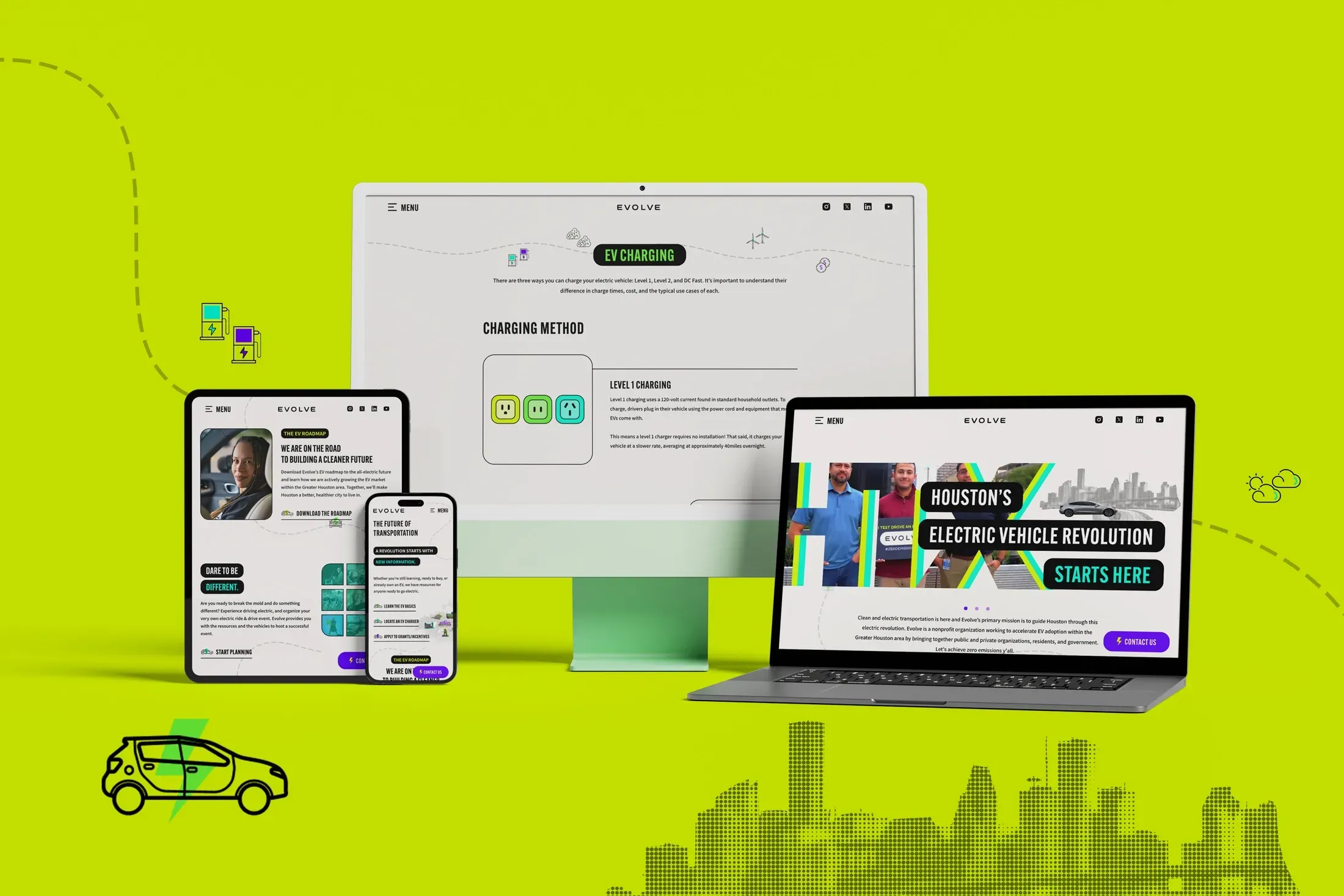Designing a Website for Gen Z: How to Capture a Generation
Designing a Website for Gen Z: How to Capture a Generation
In a sea of online content, designing a website for Gen Z requires a strategic approach tuned into their fast-paced, authenticity-seeking, and interactive world. This guide cuts through the fluff to deliver straight-shooting techniques and insights essential to engaging Gen Z users on their own digital turf.

Dan Bowen

Dan Bowen

While many are quick to label this generation as anti-social ‘mobile addicts’ with short attention spans, designers and marketers alike would be making a huge mistake to ignore Gen Z’s influence on a company’s business success. Designing your organization’s website with this generation in mind will not only open the door for future opportunities - it will also keep your brand at the forefront of the digital competitive landscape amongst this rising consumer base. To communicate effectively with Gen Z, brands need to create a relevant brand experience - and is a powerful tool to do this.
Generation Z is rapidly shaping the economic future of the world. As these new “digital natives” begin to enter the workforce, their spending power is quickly becoming more evident.
Who Are These New Digital Natives?
Gen Zs are generally defined as being born between the mid-‘90s and mid-2010s. They account for 32 percent of the global population of 7.7 billion in 2019. This generation is on track to being the most ethnically and racially diverse generation, with a large percentage from minority backgrounds. This is a vast and varied population that is poised to be the highest spending consumer group in the world. Even today, their purchasing power is estimated to be over $44 billion. This generation makes up such a big portion of online sales that businesses can’t afford to overlook them. Companies that are catering their websites toward this tech-savvy audience have the opportunity to increase sales and give your brand more traction and recognition.
- Global Population Proportion: As of 2023, the global population reached approximately 8.01 billion, with Generation Z forming a significant portion of it. While specific percentage breakdowns by generation aren't readily available for 2023, they continue to represent a substantial demographic globally (Population Reference Bureau).
- Ethnic and Racial Diversity: Generation Z remains the most racially and ethnically diverse generation, with a continuing trend where a large percentage of this group are from minority backgrounds. This diversity plays a significant role in shaping their consumer behavior and social interactions (99FIRMS).
- Purchasing Power: Generation Z's economic influence continues to grow. As of 2023, they are known for their significant online spending habits and are heavily influenced by social media and digital marketing. They are more likely to try products recommended by influencers, which highlights the importance of social media marketing strategies targeted toward this demographic (99FIRMS).
Decoding the Digital Natives: Understanding Gen Z's Online Behavior

What Do Gen Zs Care About?
Gen Zs are known for taking a cautious approach when going about their lives. They came of age during the recession, which makes them appreciate the basics of comfort and stability, they also understand the importance of planning for the future.
That might explain why Gen Zs are actively seeking careers in the tech and healthcare fields- both areas that provide a lot of stability and are always in search of new talent. Also, with many industries moving toward automated labor, post-millennials are taking control of their income by creating their own revenue streams with the use of the internet. It’s understood that post-millennials are independent, entrepreneurial and tech-savvy. It’s no surprise that many are using the web to turn their hobbies and online personas into successful business opportunities that are making them millions at younger ages. They are, at large, a smart and entrepreneurial bunch that know how to use technology and social media to influence, learn and earn.
Gen Zs were born into a harsh social and political climate. Due to the increase of online accessibility of current events and media coverage, they were introduced to the topics of terrorism, war, inequality and political controversy at very young ages. This, in turn, helped to create a population of empathetic humans that seek to break down barriers and incite changes in the environmental and political landscapes.
Gen Z’s unique characteristics and online behavior are crucial to understanding how to design effective online experiences for them. Here are some key characteristics of Gen Z:
To connect with Gen Z and meet the evolving demands of the digital marketplace, it’s essential for brands to understand their values and expectations. This generation values authenticity, expects high-speed online interactions, and is always on the lookout for the latest tech trends and gadgets. Understanding these unique characteristics is the first step in crafting captivating online spaces that appeal to Gen Z.
The Importance of Social Media Platforms in Gen Z's Life
Social media platforms have become an integral part of Gen Z’s life. Platforms such as:
- YouTube
- TikTok
- Snapchat
are used extensively by Gen Z, with 35% of them spending over four hours a day on social media primarily for entertainment and communication. Video content is particularly popular, with these platforms offering a wealth of video content that resonates with Gen Z users.
This gravitation towards social media has implications for web design. To appeal to this demographic, social media integration in web design is essential. Gen Z users frequently share content and use social platforms for sign-ins, making social integration a key consideration in web design.
Additionally, platforms like:
- TikTok
- Instagram Reels
- Twitch
- Instagram Live
offer opportunities for influencer partnerships, with short-form videos, live streams, and real-time interaction resonating with Gen Z audiences.
The Expectation for Speed: Why Slow Loading Websites Are a Turnoff for Gen Z
Speed is of essence for Gen Z. This generation is significantly more likely to leave a website if it takes more than three seconds to load, reflecting their minimal patience for slow loading pages. This insistence on speed is underscored by their high bounce rates and propensity to disengage from slow websites.
Gen Z’s preference for quickly accessing information is directly tied to their loyalty to a brand, making fast loading speeds integral for their engagement. Furthermore, they value efficient and rapid mobile experiences, indicating that websites must prioritize speed and fluidity in mobile design. In fact, they can even get frustrated with design choices that cause slow load times, such as parallax scrolling, highlighting their expectation for high-speed online interactions.
Tech Savvy and Trend-Driven: Gen Z's Values in the Digital Landscape
Generation Z, also known as Gen Z, is not just a consumer of technology; they are creators and innovators. They are constantly on the lookout for the latest tech trends and gadgets, demonstrating a high level of attraction to innovation in technology. Beyond consumption, they actively engage in content creation, coding, and other tech-driven activities, making them not just users but creators in the digital space.
Personalized experiences are highly valued by Gen Z in their online interactions, catering to their desire for authenticity. They pragmatically employ technology as a means of empowerment, education, and self-expression, and to counteract disruptive advertising, they frequently utilize ad-blocking technology, indicating a preference for subtler marketing methods.
Furthermore, features that support mental well-being and provide stress management tools resonate with them, as they often endure high levels of anxiety and stress.
Now that we’ve decoded the unique characteristics and online behavior of Gen Z, let’s turn to the practical aspect - how to design a website that appeals to this generation. There are several key considerations for web designers to keep in mind. Firstly, Gen Z responds positively to bold designs in web design, making it an important aspect to consider for engagement and aesthetic appeal. Secondly, eye-catching visuals are crucial for capturing Gen Z’s attention and effectively conveying a brand’s narrative, which serves as a bridge between the user and the brand.
In the following subsections, we’ll explore specific aspects of web design in more detail, including:
- The importance of mobile-first design
- The use of interactive features to enhance engagement
- The role of personalized experiences and tailored content in appealing to Gen Z.
Prioritizing Mobile Devices: The Heart of Gen Z's Web Access

A mobile-first mentality is crucial when designing for Gen Z. They not only rely on smartphones for web access but also consider them an integral part of their identity. With over 8 hours spent online daily and 98% owning smartphones, mobile devices are undeniably the primary means through which Gen Z accesses the web.
Mobile optimization is paramount to connecting with Gen Z. They prefer websites that are responsive and offer seamless, personalized interactions on their mobile devices. Their preferences include clean and intuitive user interfaces for mobile apps and the expectation of available and personalized customer service, such as through the use of chatbots.
Interactive Elements That Enhance User Engagement
Interactive elements are a key aspect of web design that can significantly enhance user engagement among Gen Z. For instance, gamification and rewards are effective strategies to maintain Gen Z’s engagement on mobile apps, motivating continued use through achievements and incentives. Incorporating rewards and challenges promotes interactive engagement among Gen Z users.
The popularity of video content on social media platforms resonates highly with Gen Z users. Brands can use interactive videos to:
- Allow Gen Z users to tailor their experiences, thereby increasing engagement
- Seamless integration with social media allows Gen Z users to share content effortlessly, fostering a communal interaction
- Micro-interactions, such as animated feedback or playful swipes, add a delightful dimension to Gen Z’s user experience and keep them engaged.
Lastly, offering a high level of app personalization is key for resonating with Gen Z’s value of individuality.
Personalized Experiences Through Tailored Content
Personalized experiences and tailored content are crucial in engaging Gen Z. 41% of Gen Z are willing to provide their personal data in exchange for a more customized mobile experience. Personalization within mobile apps and websites, such as tailored content recommendations and adjustable profiles, are key factors for them in improving their experience.
Gen Z values personalized communications throughout the customer journey to significantly enhance engagement, especially during key interactions such as onboarding and renewals. Platforms that deliver tailored content based on past behaviors and demographic data meet the expectations of Gen Z’s desire for personalized experiences.
Some ways to achieve this include:
- Sending personalized emails with relevant content and offers
- Using dynamic website content that adapts to each user’s preferences
- Implementing chatbots or live chat features to provide personalized assistance
- Leveraging user-generated content to foster a sense of community and connection with the brand
By implementing these strategies, businesses can effectively engage Gen Z and build long-lasting relationships with this important demographic.
Furthermore, providing them with tools for creating personalized content enhances their connection with the brand by enabling spontaneous and authentic interaction.
Avoiding Gen Z Turnoffs: What Not to Do in Web Design
While it’s important to know what appeals to Gen Z in web design, it’s equally crucial to understand what doesn’t. There are certain pitfalls that can deter Gen Z users and hinder their online experience. For instance, Gen Z dislikes intrusive ads like pop-ups and auto-playing videos, which can drive them away from engaging with a website. Non-disruptive ad placements that align with the content and do not interrupt the flow of online activities are essential for servicing Gen Z users.
Efficiency is another key aspect in web design for Gen Z. They prefer seamless navigation with clearly defined menus, calls-to-action, and a minimalistic layout approach. Poor navigation is particularly a turnoff for Gen Z; they prefer websites that offer simple, intuitive pathways to information and resources.
In the following subsections, we’ll delve deeper into these aspects.
Intrusive Features That Disrupt the User Experience

Certain features can be disruptive and hinder the user experience for Gen Z. They have a distinct dislike for intrusive features on websites such as:
- Pop-ups, because they interrupt the browsing experience and are often viewed as an annoyance.
- Autoplay videos, because they can be distracting and disrupt the flow of information retrieval.
- Slow loading times, because Gen Z users value a smooth online experience.
These features can impede the flow of information retrieval which Gen Z users prize for a smooth online experience.
Other disruptive design elements like auto-playing videos can also deter Gen Z users by detracting from the website’s main content and complicating site navigation. The overall user experience for Gen Z is significantly shaped by clean, efficient, and non-disruptive design elements that respect their desire for a smooth, self-directed online engagement.
Clunky Navigation and Inefficiency: The Frustrations of Gen Z
Efficiency in navigation is a key expectation of Gen Z. Websites that fail to provide clear navigation cues or require multiple clicks to find information can quickly frustrate them, who value efficiency and ease of use. They appreciate ‘snackable content’ with bite-sized information and easily scannable sections, which should be factored into website navigation design to maintain their engagement.
A lack of originality in web design can lead to a homogenized user experience that fails to stand out and engage Gen Z users, who are drawn to unique and memorable online spaces. It’s therefore crucial for web designers to strive for originality and efficiency in navigation to cater to the preferences of this generation.
The Gap in Representation: Ensuring Inclusive Design
Inclusivity and representation are key values for Gen Z, which they expect to see reflected across online platforms. They reject one-dimensional portrayals in media and advertising, favoring brands that actively stand for diversity and inclusivity. Incorporating authentic, diverse visuals that mirror Gen Z’s wide-ranging experiences fosters deeper engagement, reflecting their expectations for inclusive online content.
Gen Z’s heightened awareness of inclusivity issues means that non-inclusive web design can significantly diminish user engagement, as they prefer platforms that are representative of various backgrounds. An inclusive web design approach not only involves visual elements but also encompasses accessibility features for users with disabilities, aligning with Gen Z’s inclusive values and enhancing the overall user experience.
Aligning Your Brand with Gen Z's Ethos
Brands that want to resonate with Gen Z need to align their values with those of this generation. Gen Z has a strong preference for brands that are upfront, honest, and authentic in their communication. Genuine content that tells a relatable story can establish a strong emotional connection with Gen Z, fostering brand loyalty. Moreover, brands that support social causes are more likely to engage Gen Z consumers, as they prefer companies that align with their values. They are also influenced by a brand’s sustainability initiatives, as they are concerned about environmental impacts.
Collaborating with influencers can give a brand credibility and allow it to authentically connect with Gen Z consumers. Influencers who resonate with Gen Z and share their ethos can effectively endorse a brand and increase trust among this demographic. In the following subsections, we’ll delve deeper into these aspects.
Authentic Storytelling and Genuine Content

Authenticity and genuine content are key in resonating with Gen Z. They place high importance on brand authenticity, seeking out companies that are honest and genuine in their marketing efforts. Brands targeting Gen Z should collaborate with influencers for subtle product placement, focusing on building an honest bond rather than solely selling products. Utilizing influencers who align with Gen Z’s values and culture can contribute to presenting stories in a trusted and familiar format to this audience.
To engage Gen Z, it’s important to tell short, impactful stories that are visually appealing and include brand origin stories, impact stories, customer stories, educational content, and entertaining narratives. Adding value to stories for Gen Z engagement should involve providing elements like facts, figures, testimonials, benefits, features, calls to action, and social proof to establish credibility and encourage interaction.
Supporting Social Causes and Sustainability
Supporting social causes and promoting sustainability can significantly influence Gen Z’s perception of a brand. They favor brands that actively stand for social issues such as environmentalism, equality, and social justice, which influences their purchasing decisions. The integration of social and environmental values into a brand’s strategy must be genuine, as Gen Z values authenticity and is quick to dismiss brands that lack transparency.
Effective brand activism involves:
- Evaluating a company’s mission and aligning it with social issues
- Partnerships with relevant non-profits to enhance credibility in the eyes of Gen Z consumers
- Websites that prominently showcase values and social initiatives to engage Gen Z users who are drawn to brands that reflect their own commitment to societal issues.
Partnering with Social Media Influencers
Collaborating with influencers can help brands connect with Gen Z consumers and build trust. Gen Z actively seeks out new brands on social media more than any other generation, often being influenced by influencer-created content such as reviews, hauls, and ‘Get Ready With Me’ videos. Brands can effectively target Gen Z by collaborating with influencers to create genuine content that includes subtle product placements, aligning with the preferences of this demographic.
Gen Z’s purchasing decisions are significantly influenced by a brand’s social media presence and how responsive they are, highlighting the importance of integrating social media platforms with the brand’s website. This need for social integration underscores the importance of understanding Gen Z’s unique online behavior and preferences for effective web design.
Integrating Future Technologies: AR and VR in Gen Z Web Design

Emerging technologies such as Augmented Reality (AR) and Virtual Reality (VR) are shaping the next generation of web experiences for Gen Z. These technologies offer unique, immersive experiences that can significantly enhance user engagement and decision-making in the digital realm. Gen Z users expect interactive and engaging digital experiences, and have shown a preference for the incorporation of AR, VR, and gamification in online platforms.
In the following subsections, we’ll explore the potential of AR and VR in creating immersive web experiences for Gen Z.
Immersive Product Demonstrations with AR
Immersive technologies like AR create memorable brand experiences for Gen Z, fostering deeper user engagement and brand loyalty. Gen Z’s demand for innovative online experiences is driving brands to leverage AR for higher conversion rates, with interactions leading to a 94% higher conversion rate for products with AR experiences.
AR campaigns can create highly engaging and memorable experiences for Gen Z. For instance, Lush’s “Snow Fairy” AR campaign featured a personalized gifting flow, a holiday-themed face filter, and a fully immersive portal environment, resulting in an 18% clickthrough rate and an average of over 4 minutes of engagement time.

Similarly, for the launch of the film “Dune,” an AR avatar experience was created, allowing users to create custom 3D Dune avatars, which led to an average of 3-plus minutes spent in the experience and over 16,000 avatars downloaded.

VR Worlds: The Next Frontier in Online Spaces
Virtual reality (VR) offers complete immersion in a simulated environment, which can significantly enhance user engagement. Gen Z shows a strong preference for virtual reality, with 60% favoring VR as it becomes more widespread. The growing trend of online communities and experiences in VR among Gen Z is likely to drive further development in VR technologies and hardware.
VR technology extends beyond gaming and entertainment to various industries such as employee training, test-flight simulations, and even immersive dining experiences. Brands that offer VR experiences can create memorable brand experiences that resonate with Gen Z, as seen in the 3D dining experience ‘Le Petit Chef’ which uses animation and projections to create a captivating storytelling experience.
Summary
In conclusion, understanding Gen Z’s unique online behavior and preferences is imperative for effective web design. From prioritizing mobile-first design and incorporating interactive elements, to offering personalized experiences and avoiding disruptive features, every aspect of web design should cater to Gen Z’s unique needs. Moreover, aligning a brand’s values with those of Gen Z and integrating emerging technologies like AR and VR can create immersive and engaging web experiences that resonate with this generation. By decoding the digital natives and crafting a Gen Z magnet, brands can effectively engage this influential demographic and foster deeper connections.
Frequently Asked Questions

Subscribe for Insights
Sign up to our newsletter to keep current with all things design and digital.
Read our Insights
Read our Insights
Read our Insights
Read our Insights



